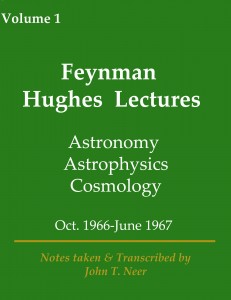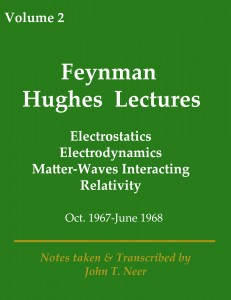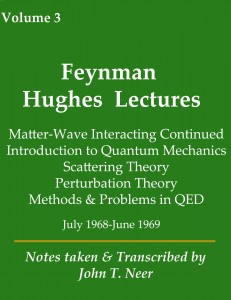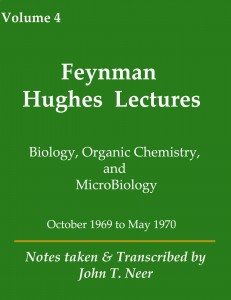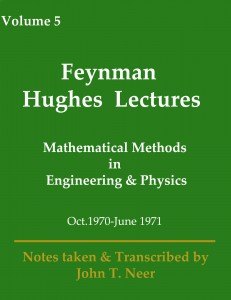These lectures notes run from the fall of 1966 to 1971. Feynman lectured prior to this period and continued on after 1971. With a few exceptions, the actual 2 hours lectures were not dated. However, the volumes in chronological order.
I want to stress, again, that these are my personal notes and are only a representation of the lectures I attended. They are to the best of my ability my recreation from memory and my original real time notes. No AV recording system was used in the transcription of my raw notes.
Volume 1
Astronomy, Astrophysics, and Cosmology
(224 pages)
Feynman solicited topic input from the scientists and engineers at the Labs for the coming year. New discoveries were being made in astronomy, astrophysics, and cosmology at the time. This 1966-1967 lecture series focused on these subjects. This volume is unique since, as far as I can tell, Feynman did not lecture on this subject matter at CalTech. While much of the material is now dated, what remains is a look into the mind of Feynman as he worked to explain such topics as stellar evolution, nuclear synthesis, cosmology, “black stars” (aka black holes), and general relativity.
I inserted more current content from the web which relates to the 1966-67 lectures with recent experimental observations and discoveries. While this lecture series has been “eclipsed” by the tremendous theoretical and experimental advancements over the past 45 years, I am sure the reader(s) will find in these lectures the power of Feynman’s insight and ability to have fun with a new subject not touched on by him at CalTech in his “normal” class and research work. I trust others, more specialized in the topics of volume 1, can and will contribute to the additional information to further enrich the notes in the future. This editing will best be done when the notes are moved and dropped in a dynamic and editable platform, yet to be identified.
The Volume I subject matter was not part of his prior lecture activity, Feynman would talk with some of his CalTech colleagues who worked in the field of astronomy, astrophysics, and cosmology about their work and theories. He would then come to the lecture literally with a (maybe 2 or 3) 3×5 cards and proceed to pour out 2 hours of theory and complex mathematical representations of the topic of the day. This was his genius and almost mystical in his ability to focus his thinking and presentation ability on the most important aspects of a given topic.
Volumes 2
Relativity, Electrostatics, Electrodynamics, Matter-Wave Interaction
(209 pages)
Feynman reflected on how he could teach his original FLP’s volume 2 & 3 differently and better than in his first pass through the subjects five years earlier. The attendees wanted him to lecture a couple years on the subject matter in the original FLP and essentially let him give his revised, enhanced, and expanded lectures. This then led more naturally into QED with a good foundation layer established. Feynman also tailored his lectures more to the level of his audience understanding they were not freshman and sophomore undergraduates but post graduate, doctorate level scientists, employed doing advanced research.
Volume 3
More on Matter-Wave Interaction, Intro to Quantum Mechanics, Scattering Theory, Quantum Theory of Angular Momentum, Intro to Lie Group, SU 2 & 3 “stuff”, Quantum Electrodynamics (QED), Pair Production
(314 pages)
Feynman went on in greater detail to complete his lectures on wave-matter interaction. From there he started into quantum mechanics and his path history formulation. He extended his lectures to include Lie Group theory and the SU 2&3 “Stuff”.
Feynman diagrams are discussed in Volume 3 at some length as he went deep into QED theory including such topics as quantum scattering. As better understood today, his diagrams represent a visual language of the complex physical processes at the particle interaction level. I have noted recently that with the power of new computers and new concepts the Feynman diagrams have, arguably, run their course. While this is possibly the case, I would assert that bypassing a fundamental understanding of the Feynman diagram concept makes it hard to understand what replaces them. This is like hand held calculators replacing the need to know the fundamental multiplication tables and being able to check what the calculator is telling you. I personally observed in a number of lectures where Feynman would self-check himself as he was working out the math because he could sense that if he kept going he would not get the right physics. This was his true genius at work. That was truly amazing to both watch and try to absorb in real time.
Volume 4
Molecular Biology
(65 pages)
The Molecular Biology lectures started out and then eventually died out as the year progressed. Feynman found the material challenging to get his head around before the lecture and, therefore, very time consuming. He apparently found a CalTech colleague, Seymour Benzer, who changed from physics to biophysics as a person who stimulated Feynman’s interest in this topic.
By consensus the lecture series ended early. Feynman was deep into his own parton theory which was his version of quark theory. He and Gell-Mann were collegial competitors in those days.
In preparing these notes for release I decided to include what notes I had of those lectures only to give evidence of Feynman’s interest to explore all the dimensions of science and nature. For those involved in the field these notes will not provide much informational value particularly with all the advancements on research and understanding of molecular biology. The value, I believe, for the reader is how Feynman thought through the subject matter and mentally organized it so he could lecture on it. That might aid teachers in this field to sharpen up their own presentation material. At the end of the volume are my un-transcribed real-time notes that I never got to but I decided to include for those who are into this field.
Volume 5
Mathematical Methods/Techniques in Physics and Engineering
(163 pages)
By some who have seen samples of my notes Volume 5 has been referred to as the “missing lectures” to the FLP “Red Books”. Feynman himself felt that he should have taught the mathematical methods first and then the physics since math is the “language” of physics. Feynman was apparently talked out of starting with a course in math-physics. The attendees at the lab talked him into a year-long lecture on his approach to mathematics as the language of physics.
I note here also that the math lectures have been referred on the Reddit by someone as “sophomoric” since all physic students must take similar course work and presumably “master” math while learning the physics. In my own case I wanted to learn the physics and minimize the math, or better said, not confused by the physics because the math was too difficult to grasp.
This is how Feynman approached physics and how he taught himself, at an early age, by developing many shortcuts through the math; “Feynman diagrams” were one clear by product of his self learning process. He did not want to get bogged down and distracted from understanding the physics. This is why and how he got involved in the Manhattan Project; he was their math wizard.
One story he told of those days: Someone came running into him needing a quick answer to a nuclear decay process that was described by some expansion series like the Sum from 1 to infinity of 1/(1+n^2)[probably not the real one]. Feynman asked how accurately he wanted the answer and the person said 10% would do for now. Feynman said he took a few seconds and said the answer was 1.3 (or something like that); the person was amazed how fast he could give him that and asked how he did it. He said since you told me you only wanted the answer to 10%, it was only necessary to go to the second term in the series expansion and that was good enough for better than 10% accuracy. This story is emblematic of Feynman’s mathematical thinking which is not sophomoric. This is why he made such a contribution to the Manhattan project and ultimately QED. He did indeed “think different”.
In my own experience I found in my graduate studies that the some of the professors tended to focus more on the math rigor than in teaching the real physics. In Feynman’s world he “felt” the physics and used the math to express that “feeling” and understanding. Language does not necessarily express the essence of the content contained in the idea being described. One must understand both the power and limitations of the language used when discussing a subject. Words don’t always express what one wants to say; so it is for math and physics.
Lecture Sidebars: Another “feature”, or aspect, of the notes is my attempt to capture “side bar” topics. These special topics or thoughts (including some philosophical ones) added color and currency to the lectures as only Feynman could deliver. He was unconstrained in the lecture environment to take off on a sidebar and the attendees both enjoyed and encouraged him to do so.
